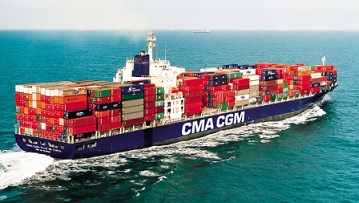IMO has developed intact stability criteria for various ship types. Its fundamental principles are to set guidelines and general precautions against vessel capsizing. The criteria set rules for safe metacentric height (GM) and righting lever (GZ)), weather criterion (severe wind and rolling criterion), the effect of free surfaces and icing, and watertight integrity. It also addressed related operational aspects like information for the master, including stability and operating booklets and operational procedures in heavy weather.
For vessel safety, the IMO Intact stability criterion must be complied with at all times.
Most cargo stowage and stability calculation software provide alarms/highlights for stability conditions not complying with the IMO criterion.
Intact stability criteria – Analyzing the data of vessels that behaved well, and especially the
data of vessels that did not survive adverse conditions, various researchers and regulatory
authorities defined criteria for deciding if the stability of a vessel is satisfactory.
Therefore,
it is important to understand that the existing stability regulations are codes of practice
that provide reasonable safety margins without giving 100% guaranty that the vessel
which meets the requirements that can survive all challenges.
According to the International Code on Intact Stability, 2008, the following criteria are
mandatory for passenger and cargo ships constructed on or after 1st January 2010:
- The area under the righting lever curve (GZ curve) should not be less than 0.055
meter-radians up to 30° angle of heel.
- The area under the righting lever curve (GZ curve) should not be less than 0.09-meter radials
up to 40° angle of the heel or the angle of down flooding if this is less than 40°.
- An area under righting curve between the angles of the heel of 30° and 40° or
between 30° and the angle of down flooding if this angle is less than 40°, should not
be less than 0.03 meter-radians.
- The righting lever GZ should be at least 0.20 m at an angle of heel equal to or greater
than 30°.
- The maximum righting arm should occur at an angle of heel preferably exceeding 30°
but not less than 25°.
- The initial metacentric height GM should not be less than 0.15 m.
- Severe wind and rolling criterion (weather criterion)
In addition to the criteria described above, ships covered by 2008 IS Code should
meet a weather criterion that considers the effect of strong beam wind and waves
applied when the vessel is in dead ship condition.
Further reading: “Ship Stability in Practice”

Safe Return to Port (SRtP)
The capsizing of COSTA CONCORDIA and fire of engine room onboard CARNIVAL TRIUMPH show that hundred years after the tragic sinking of the ocean
liner, TITANIC passenger ships are still not sufficiently safe.
“Safe Return to Port” means
new SOLAS regulations applicable to new passenger ships having their keel laid on
or after 1st July 2010, and having a length of 120m or more, or having three or more Main
Vertical Zones. As per these regulations, a passenger ship shall be designed so that the
essential systems remain operational after a fire casualty, which does not exceed the casualty threshold or the flood of any single watertight compartment. The ship can
proceed to a safe port under its power. It may sound simple in theory, but in
reality, poses a real challenge to ship designers.
A casualty threshold includes a loss of space of fire origin up to the nearest “A” class
division if space is protected by a fixed fire-extinguishing system or a loss of the
space of origin and adjacent spaces up to the nearest “A” class divisions which are not part
of the space of fire origin if it is not protected by a fixed fire-extinguishing system.
During this “Safe Return to Port” period, all persons on board are accommodated in
a “safe area” where basic services for their safety and health are available. Safe areas are
spaces (generally, internally located) where basic services such as food, water, sanitation,
other medical care, lighting, and ventilation are maintained.
If the casualty threshold is exceeded, SOLAS now requires some essential systems to be
still operational for three hours to support the “orderly evacuation” of the vessel,
considering one entire main fire zone lost.
However, it is necessary to understand that in case of long shallow side shell
damage, ships without double sides in the way of machinery spaces will capsize in the
same way as COSTA CONCORDIA, even if built according to SRtP rules.
Courtesy : https://www.wartsila.com
Further reading: MSC.1/Circ.1369 INTERIM EXPLANATORY NOTES FOR
THE ASSESSMENT OF PASSENGER SHIP SYSTEMS’ CAPABILITIES
AFTER A FIRE OR FLOODING CASUALTY
Related Topics
Draft, Trim and Heel affecting Hull Strength and Stability of containership
Corrected GoM for Hull Strength and Stability of containership
Severe Wind and Rolling criterion affecting Hull Strength and Stability of containership
Visibility from Bridge affecting navigation of containership
Propeller immersion affecting navigation of containership
Shearing forces, Bending moments and Torsional moment affecting Hull Strength and Stability of containership
Other factors affecting Hull Strength and Stability as necessary

Other info pages !
Ships Charterparties Related terms & guideline
Stevedores injury How to prevent injury onboard
Environmental issues How to prevent marine pollution
Cargo & Ballast Handling Safety Guideline
Reefer cargo handling Troubleshoot and countermeasures
DG cargo handling Procedures & Guidelines
Safety in engine room Standard procedures
Questions from user and feedback Read our knowledgebase
Home page

ShipsBusiness.com is merely an informational site about various aspects of ships operation,maintenance procedure,
prevention of pollution and many safety guideline. The procedures explained here are only indicative,
not exhaustive in nature and one must always be guided by practices of good seamanship.
User feedback is
important to update our database. For any comment or suggestions please Contact us
Site Use and Privacy - Read our privacy policy and site use information.
//Home //Terms and conditions of use
Copyright © 2015 www.shipsbusiness.com All rights reserved.



